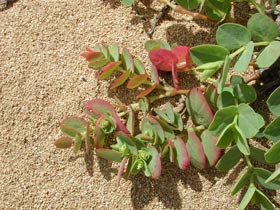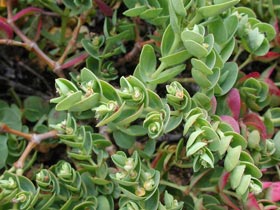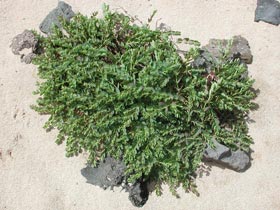Euphorbia degeneri
Genus
Euphorbia
Species
degeneri
Hawaiian Names with Diacritics
- Koko
- Kōkōmālei
- ʻAkoko
- ʻEkoko
Hawaiian Names
- Akoko
- Ekoko
- Koko
- Kokomalei
Common Names
- Beach sandmat
Synonyms
- Anisophyllum cordatum
- Chamaesyce cordatum
- Chamaesyce degeneri
- Euphorbia cordata
Distribution Status
Endemic
Endangered Species Status
No Status
Plant Form / Growth Habit
- Sprawling Shrub
Mature Size, Height (in feet)
- Shrub, Dwarf, Less than 2
- Shrub, Small, 2 to 6
Mature Size, Width
This ʻakoko commonly has a spread of 8 to 16 inches, but can also have a spread 2 feet in width.
Life Span
Long lived (Greater than 5 years)
Landscape Uses
- Accent
- Container
- Ground Cover
Additional Landscape Use Information
While there are number very troublesome garden spurges in the same genus Chamaesyce, the native ʻakoko does not become such ubiquitous pests in the landscape.
ʻAkoko are great additions to the native garden and fill in those areas in the landscape needing another plant texture.
This ʻakoko (C. degeneri) does well in full sun or windy, open areas requiring little watering. As a potted or container plant, use clay, terra cotta or cement pots and incorporate generous amounts of sand, coral rubble, and/or black cinder for good drainage. It has also been suggested to add in a small amount of red clay.
Source of Fragrance
- Flowers
Additional Fragrance Information
The pungent flowers of ʻakoko have been described as smelling like bad breath. [Kim Starr, United States Geological Survey-Pacific Cooperative Studies Unit]
Plant Produces Flowers
Yes
Flower Type
Not Showy
Flower Colors
- Green
Blooming Period
- Year Round
- Sporadic
Plant texture
- Medium
- Coarse
Leaf Colors
- Medium Green
Additional Leaf Color Information
The leaves have a red tinge.
Additional Pest & Disease Information
ʻAkoko is prone to ants, mealybugs, whiteflies, and scale.
Pruning Information
None necessary.
Water Requirements
- Dry
Additional Water Information
When plant is well established, water once a month or less during dry months. Allow plant to dry between waterings.
Soil must be well drained
Yes
Light Conditions
- Full sun
- Partial sun
Additional Lighting Information
Plant prefers full sun but can tolerate partial shade.
Spacing Information
ʻAkoko should be spaced 10 to 16 inches apart.
Tolerances
- Drought
- Wind
- Salt Spray
- Heat
Soils
- Sand
- Cinder
- Coral
Limitations
Do not overwater these drought tolerant, or xeric, plants.
Natural Range
- Niʻihau
- Kauaʻi
- Oʻahu
- Molokaʻi
- Maui
- Hawaiʻi
Natural Zones (Elevation in feet, Rainfall in inches)
- Less than 150, 0 to 50 (Dry)
- 150 to 1000, 0 to 50 (Dry)
Additional Habitat Information
A true coastal plant found in the strand vegetation.
![]() Special Features and Information
Special Features and Information
General Information
ʻAkoko belong to the Spurge or Euphorbia family (Euphorbiaceae). The genus has recently been chnged from Chamaesyce to Euphorbia.
There are seventeen native species of ʻakoko (Euphorbia spp.)--all of which are endemic to the Hawaiian Islands. A number of ʻakoko are either vulnerable, rare or endangered, with two considered extinct. Several have beautiful foliage and range in size from very prostrate sub-shrubs such as Euphorbia degeneri to Euphorbia olowaluana, which are nearly 30-foot trees--perhaps the tallest in the entire genus of 250 species worldwide!
Another native member in Euphorbiaceae is poʻolā (Claoxylon sandwicense). Some well known non-native relatives are the Castor oil plant (Ricinus communis), kukui (Aleurites moluccana), poinsettia (Euphorbia pulcherrima), cassava (Manihot esculenta), and the Pará rubber tree (Hevea brasiliensis) from which latex comes.
Etymology
The former generic name Chamaesyce is derived from the Greek chamai, on the ground, and sykon, fig, perhaps in reference to the low habit of most species and the fig-like apperance of the capsules.
The current genus is Euphorbia, and is classically supposed to have been named for Euphorbus, a physician to the king of Mauretania in the forst century A.D. (C.E.).
The specific epithet degeneri is named for the botanist Degener.
Hawaiian Names:
The name ʻakoko comes from the Hawaiian word koko for blood. They get their name from the red, or blood-colored, seed capsules appearing as drops of blood on the plant. [1,2]
Background Information
This ʻakoko (Chamaesyce celastroides) is the by far the most variable and widespread of all the Hawaiian Chamaesyce. The erect capsules (fruits) distinguish them from other species, except C. herbstii and C. rockii, which have distinctively larger fruits.
Additional References
[1] "Plants in Hawaiian Culture" by Beatrice Krauss, page 138.
[2] "In Gardens of Hawaii" by Marie C. Neal, page 516.
Plant Gallery
Back to Plant List
Other Nursery Profiles for Euphorbia degeneri



